In this Roomvu article, we look into the statistics and MLS data of the average number of bedrooms in studios, apartments, condos, half- duplexes and townhomes from 2004-2018 in Vancouver and Greater Vancouver neighbourhoods.
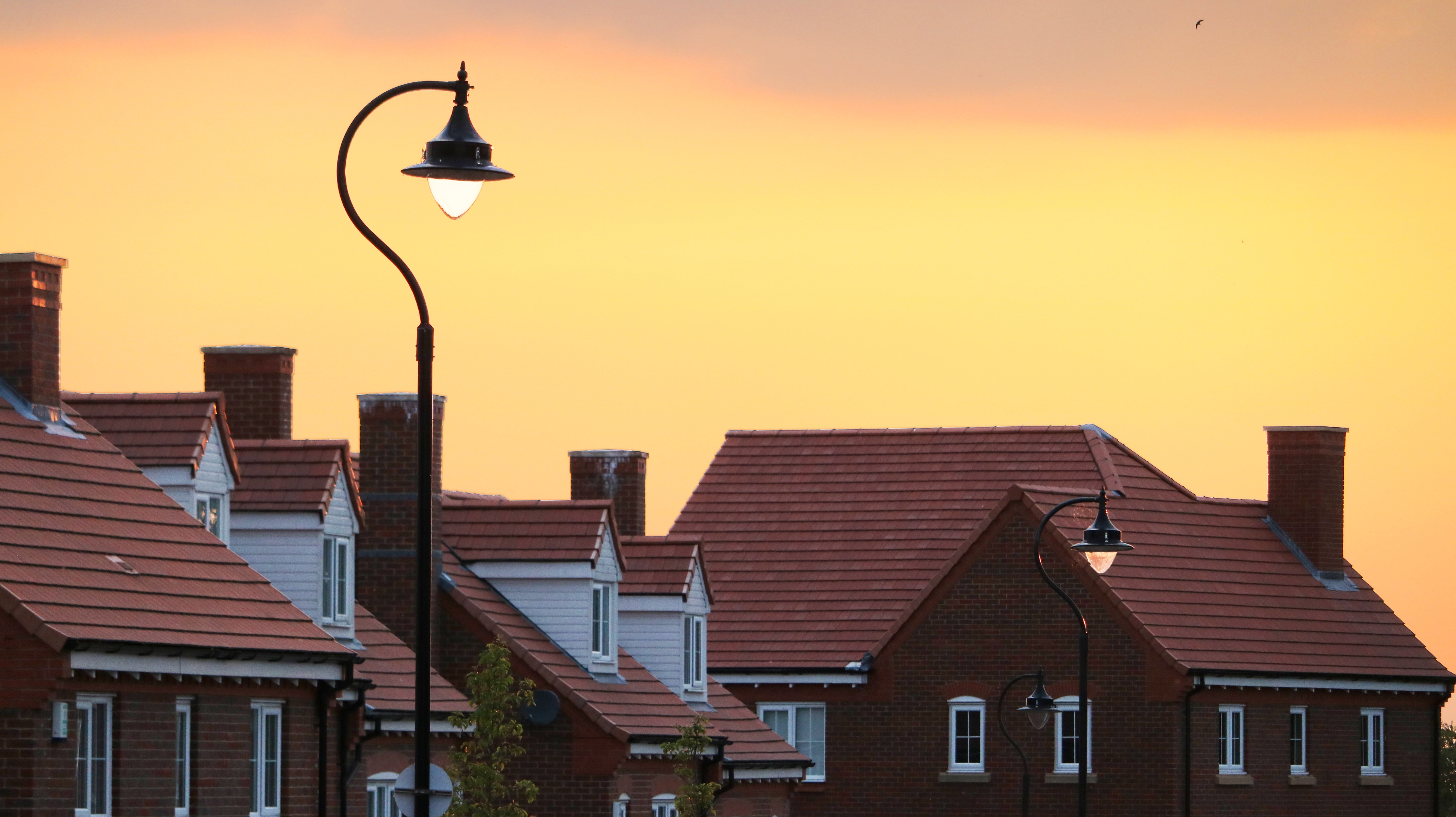
Are you curious to know the average amount of bedrooms per dwelling in your city? Our data scientist team from Roomvu along with researchers from UBC’s Sauder School of Business gathered and assessed data from apartments, condos, half-duplexes and townhomes in Vancouver and Greater Vancouver area to see what the numbers might say about your neighbourhood.
One of the interesting things is why some cities like Vancouver show an abundance of smaller bedrooms while others do not. Keep reading below to discover what we had to say about the number of Vancouver bedrooms being low.
Vancouver Bedrooms
From 2000 to 2018, the average number of bedrooms in Vancouver apartments, condos, half-duplexes and townhomes has stayed consistent – somewhere around one-room bachelor studios to two-bedroom apartments.
Based on the cost of living in Vancouver, we can assume that this trend is most likely to do with not only the popularity of living downtown (close to work, central to the city and near the ocean) but also with the cost of living. Since the cost of living is so high, people have to pay a hefty price tag for homes with more than two bedrooms.
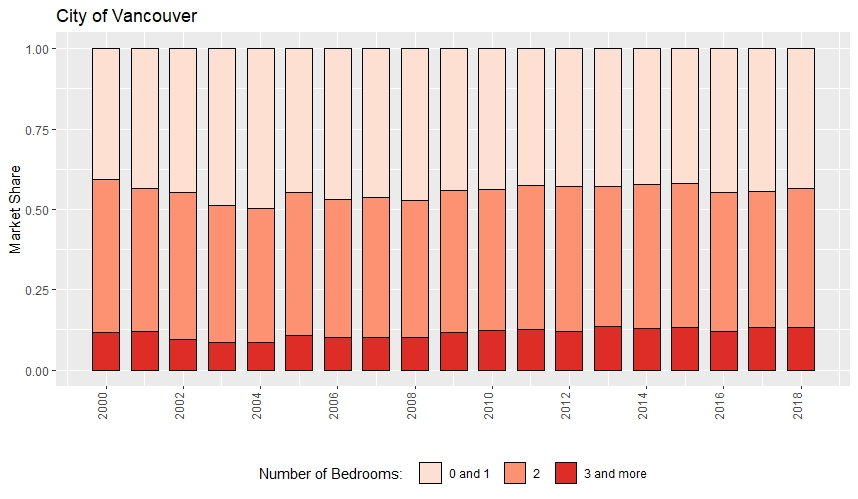
Port Coquitlam Bedrooms
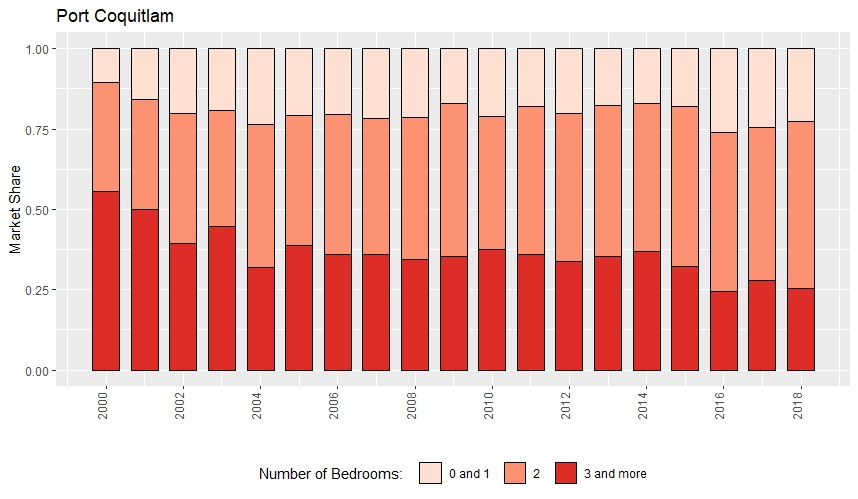
In Port Coquitlam, 3+ bedroom homes such as half-duplexes, townhomes and larger condos were popular in the early 2000s. However, in recent times, studios and two-bedroom apartments have become increasingly popular. Although large condos, half-duplexes and townhomes are still quite abundant, we see that trending downward. We cannot isolate an exact reason for this, however, it could be based on the popularity and growth in Vancouver, which has pushed home buyers towards living in the Greater Vancouver area. Additionally, the development and urbanization of Port Coquitlam have brought the city to the suburbs meaning there is less reason to leave the municipality of around 60,000 people, located about 30 kilometres east of Vancouver proper.
Pitt Meadows Bedrooms
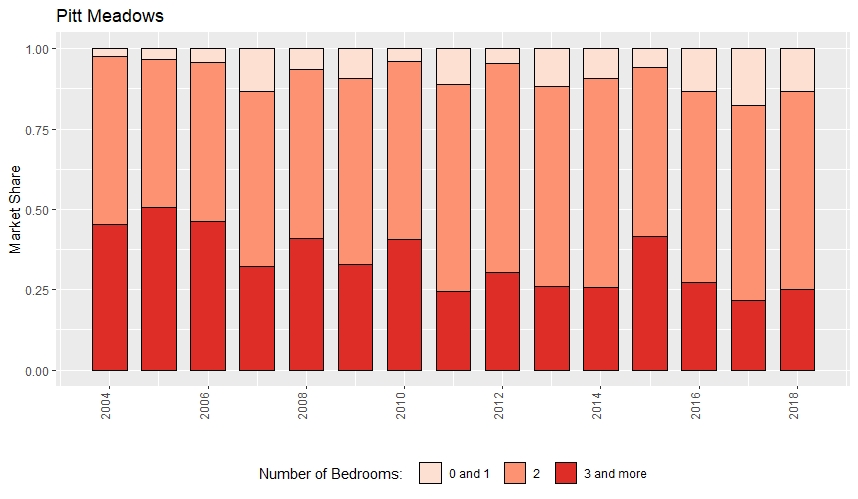
Pitt Meadows is among the fastest-growing municipalities in the lower mainland. Although Pitt Meadows is a semi-rural area, the city is still in proximity to many urban centres along the Lougheed Highway. Because of this, we see more families residing in condos, half-duplexes and townhomes. In more recent years, however, there has been growth in two-bedroom apartments due to development and the city’s popularity, bringing many of city characteristics to the semi-rural area.
Surrey Bedrooms
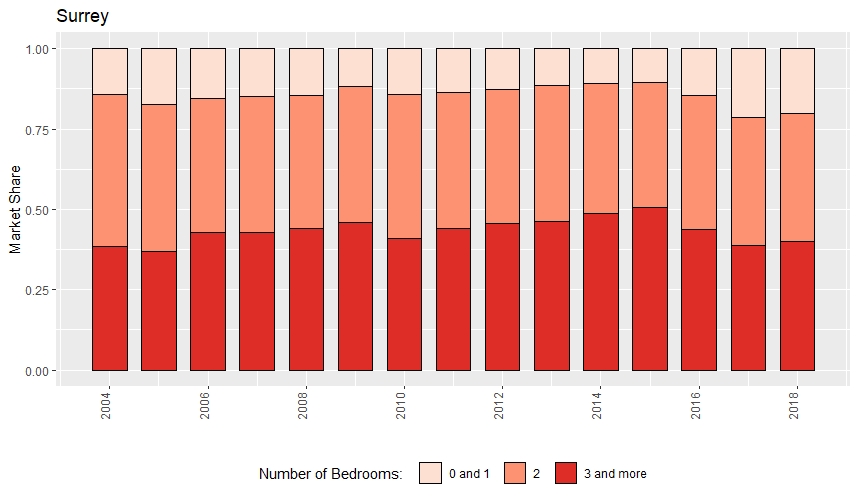
In Surrey, you can find a huge number of townhomes, half-duplexes and large three-bedroom condos as well as two-bedroom apartments over the years. However, over the last two years, the population veered more towards studio and one-bedroom apartments. This may be because the cost of living for young adults staying in larger sizes of condos, half-duplexes and townhomes is becoming higher; or because more young adults are moving to Surrey considering it’s more affordable in comparison to Vancouver, Burnaby and surrounding neighbourhoods.
Richmond Bedrooms
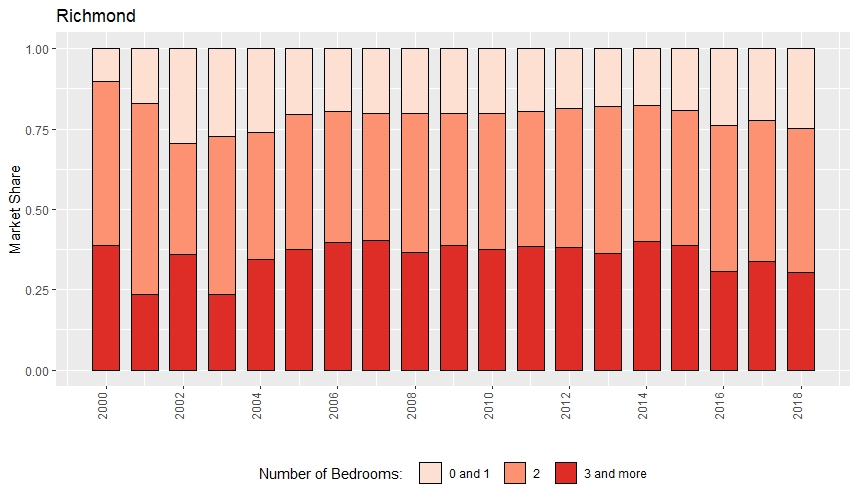
As for Richmond, the majority of attached properties belong to two and three-bedroom condos, townhomes and half-duplexes. However, from 2000-2018, studios and one-bedroom apartments became more popular — especially towards 2018, much like Surrey. We can assume this to be the result of an increase in popularity and growth in the area driving up prices for larger homes. This appears to coincide in and around 2010 when there was a rise in housing and infrastructure development thanks to the Winter Olympics
Port Moody Bedrooms

In Port Moody, unlike Vancouver, Surrey and Richmond, we see the majority of residents demographic moving towards living in two-bedroom apartments rather than studios, condos, half-duplexes and townhomes. This may be because Port Moody is further from the city, yet, still close to the ocean with beautiful views of the mountains; meaning it is relatively pricey to own homes with larger square footage but not quite as expensive as living downtown. In addition, the Port Moody area has seen a lot of development over the years making the neighbourhood trendy, modern and mobile–very attractive to a younger demographic.
Burnaby Bedrooms
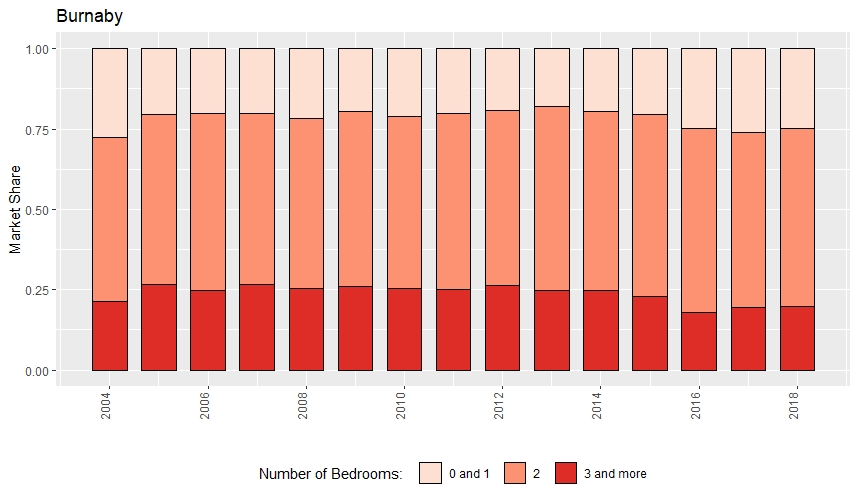
Given its close proximity to downtown Vancouver, housing in Burnaby tends to feature two-bedroom apartments, as opposed to one-bedroom ones or bachelor studios. From 2008-2018 Burnaby has not seen much change in terms of the average amount of bedrooms; however, we do see bachelor studios becoming more popular and half-duplexes and townhomes becoming less popular. We can assume this to be the result of Vancouver’s population growth, pushing residents outwards, as well as the comparatively low cost of living in Burnaby. Moreover, the biggest attraction of Burnaby is Metrotown—the third biggest mall in Canada; and additionally, being close to BCIT and SFU, Burnaby tends to house many students.
New Westminster Bedrooms
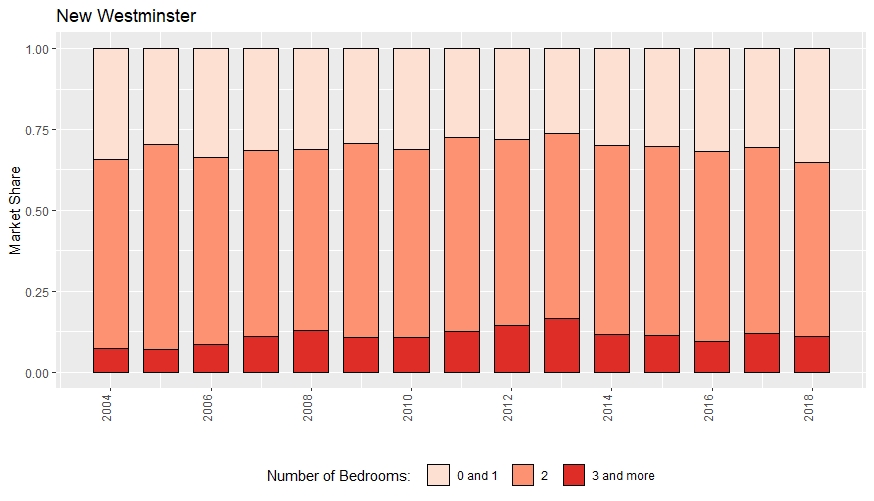
Located in the lower mainland and along the Fraser River, New Westminster is considered a fun, modern and trendy place to live–great for new families and those who like the feel of living in the city, without living in downtown Vancouver. This is because New Westminster is Skytrain accessible and quite urbanized. With that said, from 2004-2018 there has not been much change in terms of market share to the bedroom, the statistics suggest that bachelor studios, one-bedroom and two-bedroom apartments are most predominant. We can assume this is because the city consists of a younger demographic and properties may be pricier than cities further from Vancouver proper.
North Vancouver Bedrooms
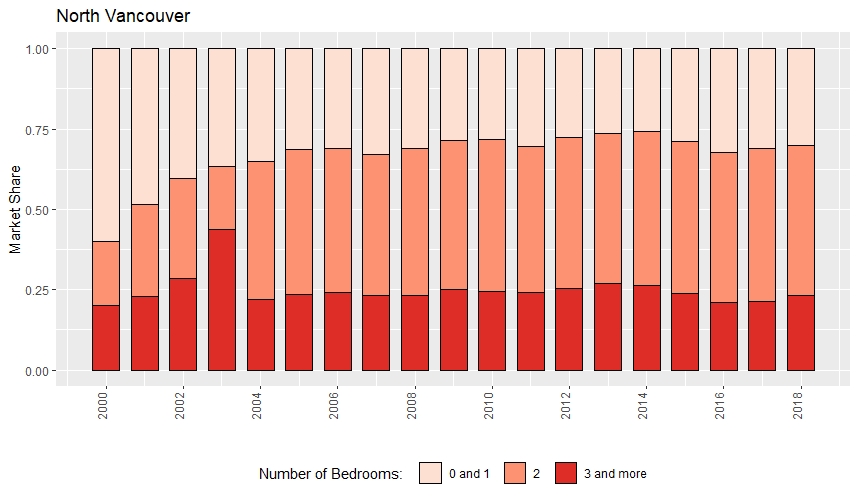
In the 2000s, studio homes and one-bedroom ones in North Vancouver were both popular and common. But like most cities in the Greater Vancouver area, developments forced many families to reside outside of the city. As a result of development and close proximity to Vancouver, we’ve watched North Vancouver transition from predominantly studio-style housing in the early 2000s to predominantly two-bedroom apartments in 2018. With that said, studios and one-bedroom condos still represent more than 25 percent of the market in this city.
West Vancouver Bedrooms
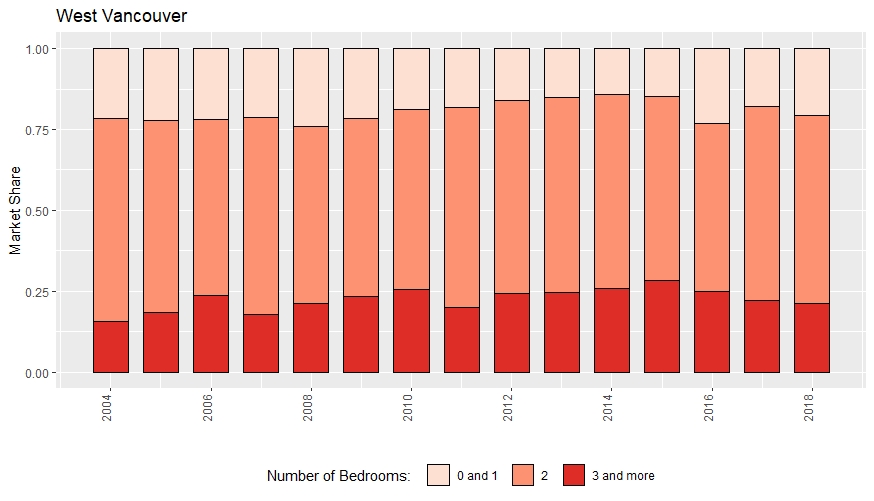
Although two-bedroom apartments are most prominent (about 50 percent of all apartments and townhomes), West Vancouver is known as a municipality with the most expensive housing in all of Canada. This being said, it is no surprise that studios and one-bedroom apartments are on the rise. However, in recent years, townhomes have also been on the rise due to more development in the area. Moreover, West Vancouver is known for its amazing views, safe neighbourhoods and easy access to the downtown core.
Maple Ridge Bedrooms
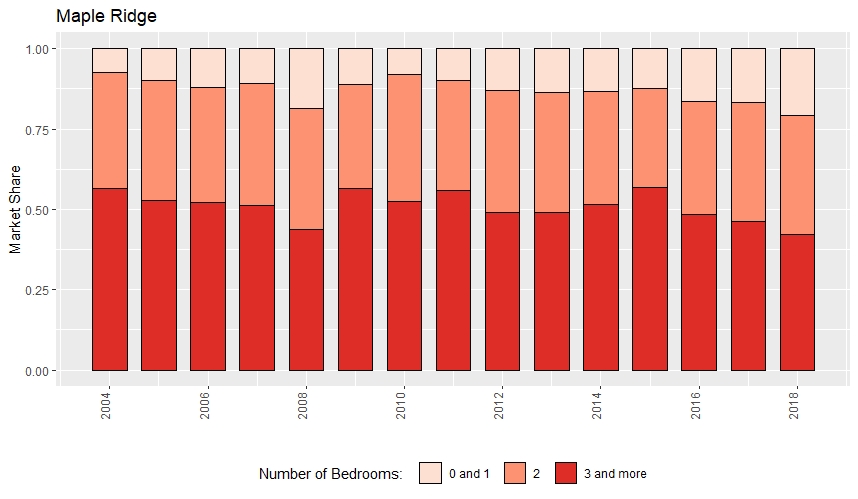
Located in the northeastern sector of Greater Vancouver, from 2004-2018, Maple Ridge remained a very stable neighbourhood for families, with the majority of homes being three or more bedroom apartments and condos, as well as half-duplexes and townhouses. Being further out from the city, Maple Ridge is much more affordable per square foot, while offering many benefits that attract families like schools, parks and shopping malls. Over the years, although there has been population growth, Maple Ridge still remains affordable; and this is reflected in the fact that three or more bedroom apartments and condos are still more prominent.
Langley Bedrooms
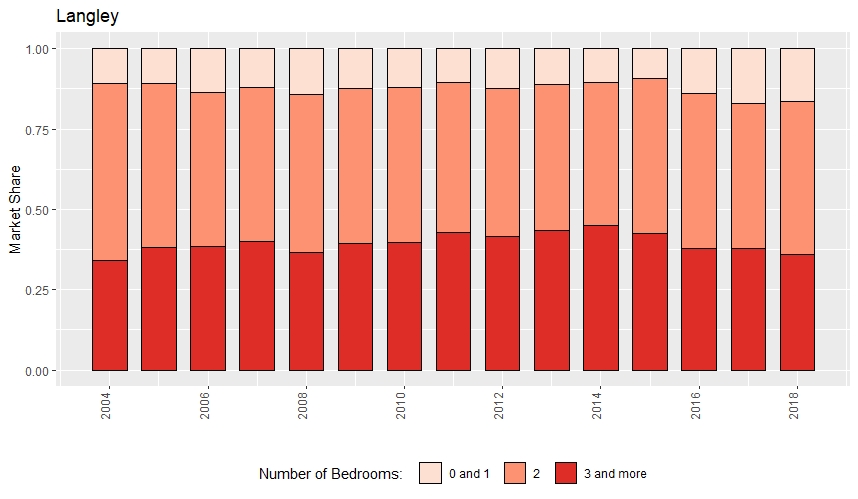
Similar to Maple Ridge in its relatively long distance away from Vancouver, Langley offers much more affordable housing per-square-foot. As a result, in Langley, we tend to see two-bedroom apartments and condos being most popular, followed by larger three or more bedroom homes, half-duplexes and townhomes. As for the trend from 2004-2018, Langley has not seen a whole lot of change in terms of the average number of bedrooms; and we can assume this to be because of the bigger homes and families that occupy this neighbourhood.
Chilliwack Bedrooms
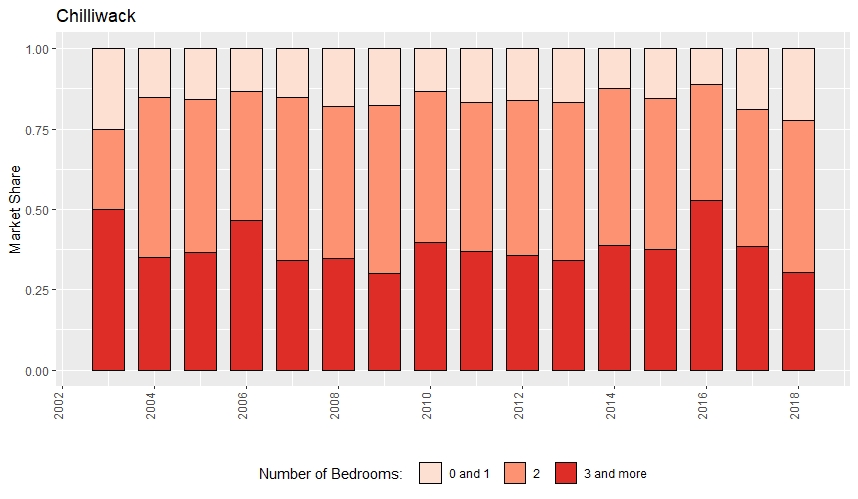
If not almost identical to Langley in terms of the average number of bedrooms from 2004-2018, Chilliwack to has a steady average of two-bedroom apartments being the most common. That said, we can assume this has to do with the number of families that reside in Chilliwack, as well as affordability in comparison to municipalities closer to the city. On top of being the second-largest city in the Fraser Valley District, Chilliwack is known for many outdoor activities such as hiking, horseback riding, biking, fishing and golfing.
Delta Bedrooms
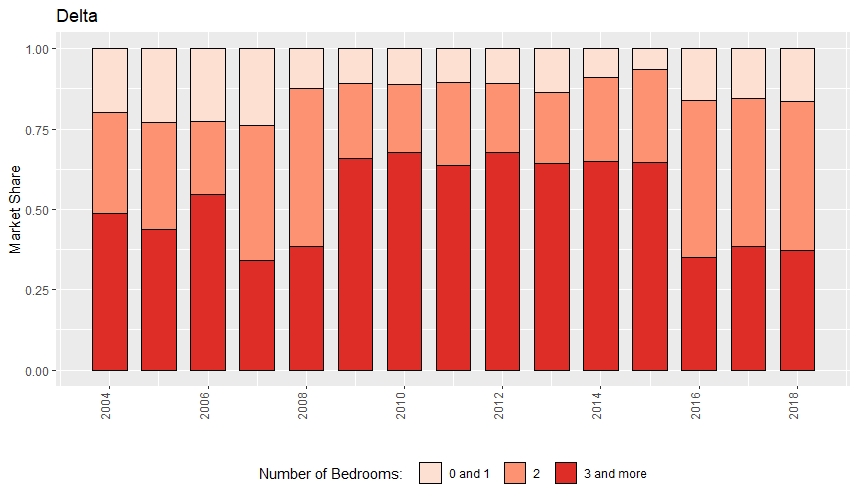
Being a very important agricultural area in Greater Vancouver, Delta is home to many young families who want to raise their children in a safe and quiet city surrounded by nature. That said, it is no surprise that three-bedroom half-duplexes and townhomes were most prominent during the 2004-2018 trend. In recent times, however, starting in 2016, there has been more focus on two-bedroom apartments as opposed to larger half-duplexes and townhomes – and this can most likely be attributed to Vancouver’s inflated housing market, development and growth of the area.
Coquitlam Bedrooms
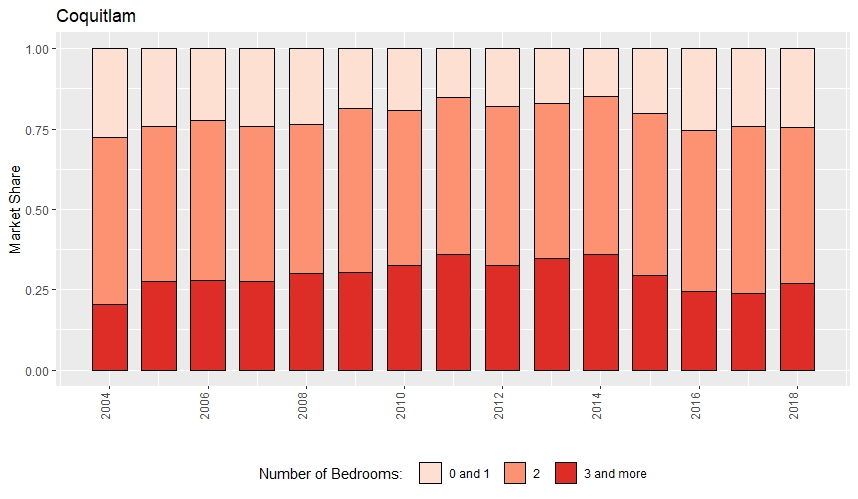
With nature trails, easy Skytrain access and beautiful lake accommodation, Coquitlam is another great neighbourhood for families to reside in. Coquitlam’s major attached housing types are also the two-bedroom apartments and condos, while one-bedroom condos and bachelor studios have also been on the rise in the last four or five years due to Vancouver’s fluctuating housing market.
Abbotsford Bedrooms
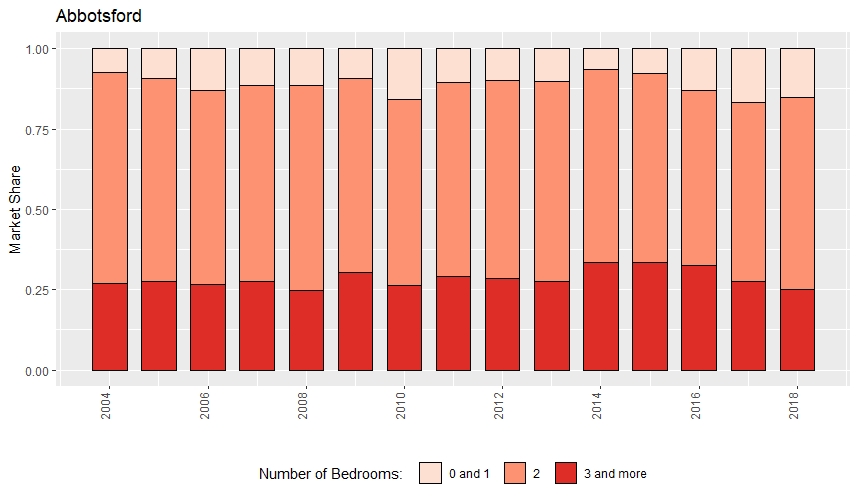
Located close to the US border and with its own international airport, Abbotsford features many rural properties, giving the city a very country feel. With more affordable housing than in the lower mainland, Abbotsford is able to offer larger homes for cheaper prices. Thus, the average types of attached housing in Abbotsford are two or more bedroom condos, half-duplexes and townhomes with very few one-bedroom and studio homes. From 2011-2018, the trend for Abbotsford homes as it relates to the number of bedrooms has not changed much considering the increase in population.
To summarize, each municipality in Vancouver and Greater Vancouver is unique not only in terms of properties but also in terms of the average number of bedrooms. This being said, that average number can indicate a lot about what it has to offer in terms of its dynamics and properties. For instance, Vancouver studios and one-bedroom apartments are on the rise.
Neighbourhoods closer in proximity to the downtown core (Vancouver, North Vancouver, New Westminster), are typically more expensive, attract younger people and have more studio, one-bedroom and two-bedroom apartments and condos. Conversely, neighbourhoods further away from the city (Maple Ridge, Delta, Surrey, Chilliwack, Port Moody, etc.), are typically less expensive, attract more families and have more large condos, half-duplexes and townhomes. Will these trends persist into the next decade? Or will a new generation of home buyers clamour for larger homes with more space? And if so, where will they have to live to find them?
